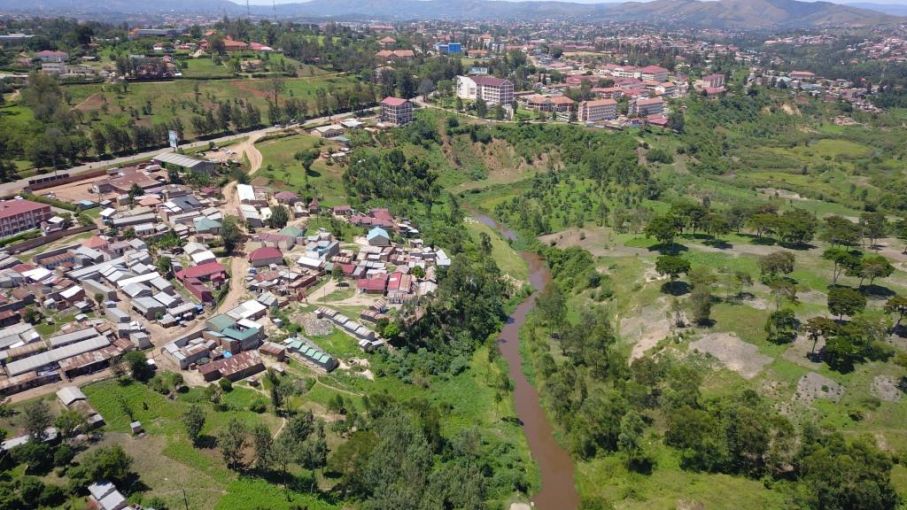The First State of Environment and Outlook Report 2018 noted that the single most critical environmental issue related to pollution of local water supplies is the recurring incidence of gastrointestinal diseases due to consumption of contaminated water.
Diarrhea, typhoid and malaria are the commonest reported primary health problems in the area, according to a 2019 USAID report on the Lakes region.
In early 2010, access to latrines in the region was a huge challenge, with 83 percent of assessed settlements not using latrines — mostly because they were not available. Although the use of boreholes has improved in recent years, 11 percent of the population still relies on unimproved drinking water sources such as open ponds, which expose them to water borne diseases. This is worsened by a majority of people defecating in the open, which contaminates unprotected water sources, such as rivers.

As a nonprofit journalism organization, we depend on your support to fund more than 170 reporting projects every year on critical global and local issues. Donate any amount today to become a Pulitzer Center Champion and receive exclusive benefits!
Yan Dior Dak, a mother of eight, has been living along Panyi River for more than 25 years.
She says the entire village drinks water directly from river ponds, adding that there has never been any borehole or purified water source in the area since she was born.
“We drink water in this river. We cook with the same water. We have no boreholes. The water is not clean ... [there is] no way for other water sources anywhere. We have to take it like that. The only clean water we drink is when we collect rain water. No any NGOs or government has ever come here and help people. Nothing has been done,” Yan Dior Dak said.
According to the First State of Environment and Outlook Report 2018, collection, transportation and final disposal of both solid and liquid waste are inefficient or non-existent in most South Sudanese towns.
Most urban waste is burnt, resulting in the proliferation of vectors, flies and rodents leading to respiratory illnesses.
Lack of proper sewage and water treatment systems means human waste contaminates water for human consumption, increasing illnesses.
David Ngong, Episcopal Church of South Sudan Diocesan Bishop of Yirol, said people are exposed to bacteria through drinking unsafe water.
He said that until the late 1990s, when government and other nongovernmental organizations introduced a few boreholes in the town Centre, there was no other water source in the area apart from the river.
“This is the lake where people drink from and also animals drink from the same lake. People are surviving without knowing that the water is dirty. The quality of water is not good but few people have been trained how to purify water. When it rains, every waste is washed into the river. People drink the same water with animals. That explains why cases of diarrhea are common. Usually in December people resort to using hand pumps in some areas,” Bishop Ngong explained.
According to USAID, access to water was also a security concern, especially for women and girls, who often have to walk long distances on their own to fetch water.
More than 65 percent of the population has access to water within an hour’s walking distance.
The Water Project in Lakes State, funded by the Netherlands government from 2013 to 2019, aimed at contributing to national security and reduction of dependence on food aid in South Sudan by using water provision as an entry point for economic development.
Communities in Lakes region received access to safe water and were trained to start income-generating activities to improve their livelihood and keep water flowing.
By 2016, about 39 Village Sanitation Committees were formed and 312 Village Health Volunteers were trained.
The Inspector General for Database and System Administration in the Ministry of Water Resources and Irrigation Gabriel Majok Bol said the project provided nearly 742 boreholes in total, including rehabilitation and drilling of others.
According to the Project website, by 2016 (three years before the end of the project), more than 80 boreholes had been drilled and 131 had been rehabilitated, providing improved access to safe water from 135,000 to 225,000 people in the Lakes region.
Gabriel Bol said the project provided capacity building to communities, trained them on income-generating activities, sanitation, agri-business production, fishing and other technical knowledge.
“The communities were trained on hygiene, staff members were trained, and technical staff on boreholes were also trained. There was a training at the end of the project to the staff members of the Ministry. One of the staff members to the project, Engineer Benjamin, was sent to Nairobi. The facilities are still being maintained because the project addressed sustainability of the facility and sustainability depends on the communities after the lifeline of the project. I believe they are still using the facilities at the moment, despite all what might occur,” he said.
The project also helped pastoralists take their livestock to drink from boreholes during the dry season, when other sources of water are scarce.
Gabriel Bol said the project helped women access water easily.
“Before, when there were few boreholes and water points, it used to be congested. Many women used to travel long distances to fetch water. They could even fight amongst one another during water collection.
This story was produced in partnership with InfoNile and Code for Africa, with support from the Pulitzer Center and National Geographic Society; edited by Annika McGinnis.









